1. Take home spicy snacks are growing nearly 9% year-on-year
2. Indie retailer-led snack launches can achieve sizzling sales
3. CSN is worth over £4.3bn and growing in value +9.9%
4. Health is the fourth most important driver to snack purchase
5. Jerky and biltong meat snacks are up 8.2% in grocery
6. In the past year, the healthier snacking segment has grown rapidly at +11.2.%

1. Take home spicy snacks are growing nearly 9% year-on-year
If you can’t stand the heat, get out the c-store (or at least stick to ready salted). That’s the message from crisps, snacks and nuts brands as they join an epic quest for spice not seen since Dune 2 was on at the cinema.
Chief among them is PepsiCo, which collaborated with select c-store retailers to ensure the April launch of its Extra Flamin’ Hot Doritos, Walkers Max and Wotsits Crunchy variants packed some proper sizzle. “Consumers are showing a real demand for spice in the savoury snacking sector where [take home] spicy snacks are growing nearly 9% year on year [Kantar],” says PepsiCo head of wholesale Mike Chapman.
“Within the UK in particular, over 51% of consumers say they love spice spicy foods – second only to Turkey in those European markets in terms of preference for heat [Quantitative Usage and Attitude Study, Ipsos, 2022]. We’ve very much reacted to that consumer demand.”
Aman Uppal from One Stop Mount Nod in Coventry was one of the retailers involved in the launch. He believes that it’s at the extreme end of the flavour dial that products are really cutting through in-store. “It’s all about the extremes at the minute: extreme heat and extreme sourness,” he says. “I don’t know who’d want to combine the two, but that would definitely be an interesting product!”
Chapman says that the hotter flavour profile especially chimes with Gen Z consumers. He believes they’re looking for different snack propositions which offer “that difference, that boldness.”
Raaj Chandarana from Tara’s Londis in High Wyecombe confirms that, when it comes to NPD, it’s this boldness which pays dividends.
“If NPD in snacks is something like standard spicy barbecue flavour customers are more likely to say ‘No thanks, I’ll stick to what I know’,” he says. “But if it’s something like the Takis variant Walkers’ brought out, or even McCoy’s Chip Shop Curry, if it’s something that feels quite wacky and out-there then customers are more willing to take a punt on it.”
However, Burts Snacks maintains that “nuanced” flavours are an important part of the heat spectrum too. “Our Reaper Chilli and Lime Ridges are perfect for those seeking an exhilarating heat experience,” states the firm. “Using local ingredients, they bring the heat by using chillies from the South Devon Chilli Farm. The Hand Cooked crisps sector is experiencing significant growth surrounding these Chilli flavoured varieties, with a value growth of 15.5%. This growth solidifies that spicy flavours are popular among consumers.”
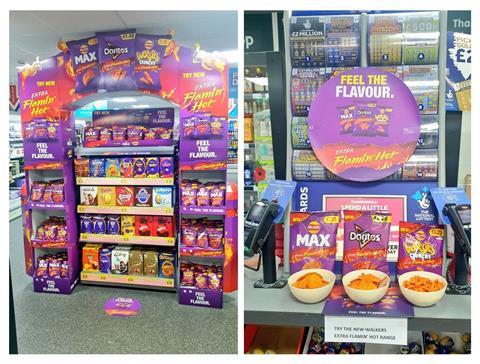
2. Indie retailer-led snack launches can achieve sizzling sales
Retailers have already reported red-hot sales for the new PepsiCo Extra Flamin’ Hot flavours. Aman believes that some of that in-store success is down to the “unique” way stores were involved.
“Normally brands deliver ready-made POS solutions to stores – and one size doesn’t always fit all,” he says. “We were approached by Cirkle PR and PepsiCo to be part of the launch right from the start with a panel of other retailers. So we were on calls last year and early in January to look at the visuals and give our views on what would work.”
Out of those calls came a tiered system for launch POS, based around ‘mild’, ‘hot’ and ‘hottest’ tiers. Different tiers involved different levels of striking purple POS from FSUs to floor stickers.
Aman opted for a huge POS arch in-store, stacked with Extra Flamin’ Hot crisps, as well as offering till point tasters of each flavour (see above).
“This was probably the first activation I’ve seen that had a clear narrative and theme throughout,” he says. “So whatever sort of size of tier you were, you weren’t losing any impact.”
Importantly, all stores received stock ahead of the launch – giving c-stores a head-start on both mults and wholesalers.
Aman says that the results in his store were “extra-hot”.
“The response has been fantastic from customers. I really felt like I was part of something, which made me want to give it my all. It’s showing that if retailers are involved from the start we can really shape these launches.”
3. CSN is worth over £4.3bn and growing in value +9.9%, with PMPs driving sales
It’s a truth universally acknowledged that a shopper who wants a bit of low-cost comfort after a tough day will be after a bag of salty snacks.
“In difficult financial times, the CSN category prospers as shoppers look for affordable tasty treats, representing a critical opportunity for retailers to grow footfall and sales,” says Matt Collins, trading director at KP Snacks.
Raaj can see what he means. While he speaks appreciatively of the big buzzy launches in the category, “there’s an argument that people are sticking to the core range right now.”
“I think that a lot of people are sticking to what they’re used to, because it’s such an unprecedented time,” he says.
“I’m making that link to comfort, that they’re buying what they think of as ‘safe’”.
Part of that safety means offering a price shoppers won’t curse-out at the check-out.
“For us pricemark is king,” says Raaj. “We do have some of the big bags [of crisps] but they only really sell when they’re on offer. We just can’t get away with selling a massive bag of Dorito’s for three quid or anything like that. But when it’s on offer, or we have a linked deal, then people go for that value.”
“PMP formats have seen significant growth in recent years and will stay increasingly relevant as the cost of living remains high,” says Collins.
“PMPs offer consumers great value for money, with clear pricing reassuring shoppers that they’re getting a good deal. Worth over £350.3m [Nielsen IQ, Total Coverage, Total PMPs Value, MAT 25.10.23], the PMP format is popular within CSN, with 57% of impulse shoppers buying PMPs [Lumina Q1 Convenience Strategy Forum 2023].
KP has one of the all-time-favourite pocket-money-friendly brands in its portfolio, Space Raiders at 40p, alongside heritage brands like Discos, Skips and Wheat Crunchies at 50p, and Hula Hoops’ core range and Pom Bear at 65p.
“We also produce four of the top five large PMP SKUs, with Hula Hoops Big Hoops BBQ Beef (the best-selling PMP on the market [Nielsen], McCoy’s Flame Grilled Steak, Nik Naks Nice ‘N’ Spicy and Nik Naks Rib ‘N’ Saucy are all available as £1.25 PMPs,” adds Collins.

4. Health is the fourth most important driver to snack purchase
While exotic flavours have found favour with shoppers, consumers have still got one eye on the health factor when making purchases.
“International flavours and formats and health are two big trends – those with lower salt and especially lower fat,” says Epicurium’s marketing manager, Richard Jefferson.
“Consumers are increasingly focused on their health and wellbeing and are looking for healthier alternatives to the traditional favourites. They are also increasingly looking for convenience when it comes to purchasing – they want to be able to grab something quickly and easily, and many are looking for smaller, single-serve options that they can carry with them.”
Chapman maintains that health is especially important to Gen Z shoppers who actively consider it when shopping the category.
“Two years ago, we set out quite a bold ambition that by 2025 we’d have half of our snacking sales from a healthier alternative. So that would either be a non-HFSS product or in portions that are under 100 calories or less,” he says.
Chapman cites Walkers’ low-salt, Walkers’ baked and Popworks as three examples where PepsiCo is offering a healthier alternative – while still maintaining plenty of taste and choice.
Meanwhile, Raaj understands the importantce of healthy products. Yet he’s not sure they’re going to set c-store tills blazing quite yet.
“[Health] is a really good question,” he says. “Because you’ve got your lentil chips and all these sorts of things – but are they really in the top 20 sales for anyone?
“I think manufacturers have an obligation to show they’re on trend and care about that sort of stuff. But will people make it a daily occurrence when they’re snacking and having a big night in? I don’t think so.”
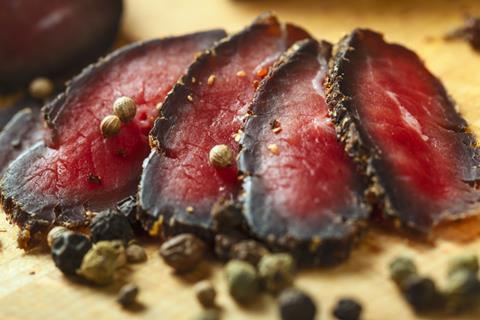
5. Jerky and biltong meat snacks are up 8.2% in grocery
Thanks to The Simpsons, many shoppers associate jerky solely with c-stores. And as the trend for protein-packed snacks continues, it’s enjoying a second act as a semi-health food.
In fact, the jerky and biltong meat snacks category is one of the fastest growing in grocery [Nielsen Feb MAT 2024], worth over £34m in retail sales.
“The opportunity to unlock additional sales is huge,” says Shaun Whelan, Jack Link’s convenience/wholesale OOH controller.
“The jerky and biltong meat category has nearly doubled in value over the last five years and has the headroom to double again as still less than one in ten households buy it. High protein meat snacks is a high-growth opportunity convenience retailers cannot afford to miss.”
Also in meat snacks, lunchbox favourite Peperami has gone premium, with a new Tapas range featuring chorizo and salami.
“There is no standard store shelf size for convenience stores and that is why Peperami comes in a versatile SRP – so Peperami can be merchandised standing up, length or narrow ways,” says Shaun Whelan, LSI convenience/wholesale and OOH controller.

6. In the past year, the healthier snacking segment has grown rapidly at +11.2.%
Across the retail industry HFSS is definitely a four-letter word. Yet its impact has most heavily fallen on the mults.
“I think we’ve seen less of an impact [of HFSS] on convenience retail, and I think that’s borne out by the fact that a lot of the retailers didn’t fall into that definition of the legislation,” says Chapman.
For the c-stores that do they’ve had to work hard on rejigging their ‘banned’ impulse snacks to other parts of the store.
“I think it’s then important that retailers really work on getting that main aisle right,” says Chapman. “So it’s about making sure that destination aisle is impactful and well merchandised. You’ll see some of our Walkers’ branded bays out there in the marketplace to really make it easily shoppable for the consumer.”
Jefferson adds that HFSS is also a chance to reconsider adding some of the new generation of plant-based snacks.
“Not only does it help to fill the shelving space impacted by HFSS requirements with great impulse buy options, but it also means retailers can tap into the growing trend of plant-based snacking, as well as health and wellness, in particular gut health and free-from snacking.
“Overall, sales of HFSS products remain strong as the products continue to hit a specific consumer trend.”

























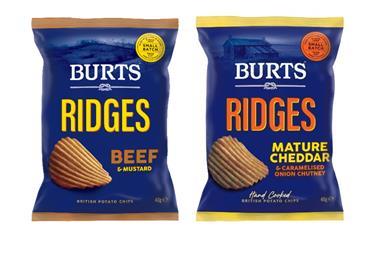

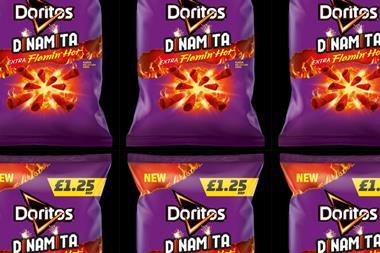

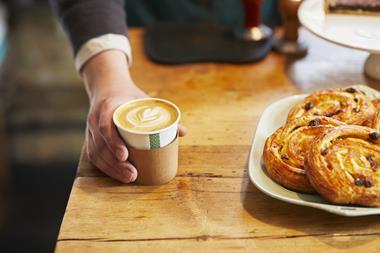




No comments yet